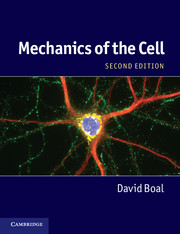Book contents
- Frontmatter
- Contents
- Preface
- List of symbols
- 1 Introduction to the cell
- 2 Soft materials and fluids
- Part I Rods and ropes
- Part II Membranes
- Part III The whole cell
- Appendix A Animal cells and tissues
- Appendix B The cell’s molecular building blocks
- Appendix C Elementary statistical mechanics
- Appendix D Elasticity
- Glossary
- References
- Index
Appendix C - Elementary statistical mechanics
Published online by Cambridge University Press: 05 June 2012
- Frontmatter
- Contents
- Preface
- List of symbols
- 1 Introduction to the cell
- 2 Soft materials and fluids
- Part I Rods and ropes
- Part II Membranes
- Part III The whole cell
- Appendix A Animal cells and tissues
- Appendix B The cell’s molecular building blocks
- Appendix C Elementary statistical mechanics
- Appendix D Elasticity
- Glossary
- References
- Index
Summary
Soft materials, such as the filaments and membranes of the cell, may be subject to strong thermal fluctuations and sample a diverse configuration space. Each of these accessible configurations, of varying shape and energy, contribute to the ensemble average of an observable such as the mean length of a polymer chain. Statistical mechanics provides a formalism for describing the thermal fluctuations of a system; in this appendix, we review several of its cornerstones – entropy, the Boltzmann factor and the partition function – following a compact approach laid out in Reif (1965). As applications, the thermal fluctuations of a Hooke’s law spring and the entropy of an ideal gas are calculated.
Temperature and entropy
Any configuration available to a system, be it a polymer or a gas in a container, can be characterized by its energy, although more than one configuration may have the same energy. At zero temperature, the system seeks out the state of lowest energy, but at non-zero temperature the system samples many configurations as it exchanges energy with its environment. To determine the magnitude of these energy fluctuations, let’s examine two systems, L and S, in thermal contact only with each other, as in Fig. C1.1. System S is the subject of our observations, while L is the reservoir; L has far more energy than S. Because L and S exchange energy only with each other, their total energy, ETOT, is a constant :
ETOT = EL + ES. (C1.1)
We now specify ETOT to be a particular value Eosub>, say ETOT = Eo = 106 Joules.
- Type
- Chapter
- Information
- Mechanics of the Cell , pp. 539 - 545Publisher: Cambridge University PressPrint publication year: 2012



